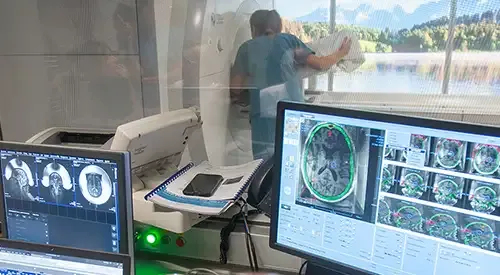Ataxia. Lack of muscle control
"It is important to carry out an exhaustive diagnostic study of patients with ataxia in order to identify those who can improve with specific treatments".
DR. ROSARIO LUQUIN PIUDO
SPECIALIST. NEUROLOGY DEPARTMENT

Ataxia is a motor disorder characterized by a lack of coordination in performing voluntary movements that alters their speed and accuracy. This lack of coordination affects walking, limbs and speech.
The diagnosis of ataxia is always clinical and is based on the analysis of the symptoms and signs presented by the patient.
The neurological examination should be thorough and focused on the exploration of eye movements, movement coordination and gait.

What are the symptoms of ataxia?
The symptoms mainly affect the coordination of voluntary movements. The most characteristic are:
- Instability when walking, which generally causes an increase in the support base during walking. In advanced cases the instability can affect the trocar and produce difficulty in remaining seated.
- Incoordination of the voluntary movements in arms and legs, which produces difficulty in performing precision movements and in many cases there is also trembling.
- Speech alteration with difficulty in articulation and control of voice volume, tone and breathing.
- Alteration of the movements of the eyes that can produce double vision (diplopia) or sensation of movements of the objects (nystagmus).
The most common symptoms are:
- Instability when walking.
- Incoordination of movements of arms and legs.
- Speech alterations.
- Alterations in eye movements.
Do you have any of these symptoms?
You may have an ataxia
What are the causes of ataxia?
Ataxia can be the initial and only symptom throughout the course of a disease, or it can appear along with other signs and symptoms in the course of the disease.
Acquired causes
- Metabolic, nutritional, and toxic toxins: malabsorption syndromes, alcoholism, thiamine deficit, hypothyroidism, drugs.
- Ataxias of immunological cause. We must differentiate those in which the target of autoimmunity is the cerebellum (autoimmune cerebellar ataxia, paraneoplastic, associated with gluten intolerance, thyroiditis, etc.) and others in which the target of autoimmunity are various structures of the central nervous system (multiple sclerosis, connective tissue diseases).
- Ataxias produced by structural lesions of the cerebellum or its connections (stroke, tumors, trauma, multiple sclerosis, infectious etc).
- Degenerative ataxias such as multisystemic atrophy in which other alterations such as parkinsonism are associated.
Hereditary causes
They are classified according to the pattern of inheritance into autosomal dominant (known as ACS), recessive (the most frequent is Friedreich's ataxia), X-linked and associated with mitochondrial diseases.
In all of them there is as a predominant symptom a progressive ataxia that leads to the loss of ambulation in about 15 years.
Other symptoms that may appear associated with ataxia include: alterations in eye movement (ophthalmoplegia), involuntary movements, mental deterioration, epileptic seizures or peripheral neuropathy, pyramidal alteration.
How is ataxia diagnosed?

The diagnosis of ataxia is always clinical and is based on the analysis of the symptoms and signs presented by the patient. A detailed clinical history must be taken in which family history (family history of similar symptoms) and personal history (habits and previous illnesses) are gathered.
The neurological examination should be thorough and focused on the exploration of eye movements, coordination of movements and gait. It is also important during the exploration to check if there is an alteration of other structures of the central and/or peripheral nervous system besides the cerebellum.
In the diagnostic study of ataxias, special attention must be paid to detecting those that are treatable. Therefore, a complete blood analysis should be performed to exclude an autoimmune origin (including paraneoplastic ataxias), metabolic [thyroiditis, cholesterol metabolism (Niemann Pick and Xanthomatosis brain tendon), etc] toxic (alcohol, drugs, drugs).
It is essential to perform a cerebral magnetic resonance to check the integrity and/or lesion of the cerebellum and the rest of the central nervous system. Depending on the data of the clinical history, if a possible hereditary origin is suspected, a genetic study is performed.
How is ataxia treated?
The treatment of ataxia depends on its origin. Some patients are treatable with specific interventions, as may be the case of some ataxias of deficiency or metabolic origin, surgical or chemotherapeutic treatment in cases of ataxia of tumorous cause or in ataxias of immunological origin, with the use of immunomodulatory drugs.
These treatments are often complemented by neurorehabilitative treatment specifically aimed at the specific symptoms of each patient. Ataxias of hereditary cause can benefit from rehabilitation treatment.
Also consider specific treatments for pathologies that appear in some ataxias such as heart disease or musculoskeletal disorders (scoliosis, pes cavus, etc.)
Where do we treat it?
IN NAVARRE AND MADRID
The Department of Neurology
of the Clínica Universidad de Navarra
The Neurology Department has extensive experience in the diagnosis and multidisciplinary treatment of neurological diseases.
We offer a diagnosis in less than 72 hours, along with a proposal for personalized treatment and post-consultation follow-up of the patient by our specialized nursing team.
We have the most advanced technology for an accurate diagnosis with cutting-edge equipment such as HIFU, deep brain stimulation devices, video EEG, PET and epilepsy surgery, among others.

Why at the Clinica?
- State-of-the-art diagnostic assistance with great work in research and teaching.
- Specialized nursing team.
- We work together with the Sleep Unit.


















